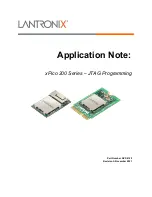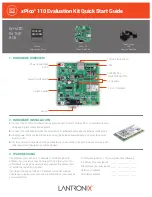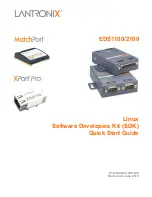QUEUED SERIAL MODULE
MC68332
6-28
USER’S MANUAL
The transmission complete (TC) flag in SCSR shows transmitter shifter state. When
TC = 0, the shifter is busy. TC is set when all shifting operations are completed. TC is
not automatically cleared. The processor must clear it by first reading SCSR while TC
is set, then writing new data to TDR.
The state of the serial shifter is checked when the TE bit is set. If TC = 1, an idle frame
is transmitted as a preamble to the following data frame. If TC = 0, the current opera-
tion continues until the final bit in the frame is sent, then the preamble is transmitted.
The TC bit is set at the end of preamble transmission.
The send break (SBK) bit in SCCR1 is used to insert break frames in a transmission.
A nonzero integer number of break frames is transmitted while SBK is set. Break trans-
mission begins when SBK is set, and ends with the transmission in progress at the
time either SBK or TE are cleared. If SBK is set while a transmission is in progress,
that transmission finishes normally before the break begins. To assure the minimum
break time, toggle SBK quickly to one and back to zero. The TC bit is set at the end of
break transmission. After break transmission, at least one bit-time of logic level one
(mark idle) is transmitted to ensure that a subsequent start bit can be detected.
If TE remains set, after all pending idle, data and break frames are shifted out, TDRE
and TC are set and TXD is held at logic level one (mark).
When TE is cleared, the transmitter is disabled after all pending idle, data and break
frames are transmitted. The TC flag is set, and the TXD pin reverts to control by PQS-
PAR and DDRQS. Buffered data is not transmitted after TE is cleared. To avoid losing
data in the buffer, do not clear TE until TDRE is set.
Some serial communication systems require a mark on the TXD pin even when the
transmitter is disabled. Configure the TXD pin as an output (DDRQS), then write a one
to PORTQS bit 7. When the transmitter releases control of the TXD pin, it reverts to
driving a logic one output.
To insert a delimiter between two messages, to place nonlistening receivers in wakeup
mode between transmissions, or to signal a retransmission by forcing an idle line, clear
and then set TE before data in the serial shifter has shifted out. The transmitter finishes
the transmission, then sends a preamble. After the preamble is transmitted, if TDRE
is set, the transmitter will mark idle. Otherwise, normal transmission of the next se-
quence will begin.
Both TDRE and TC have associated interrupts. The interrupts are enabled by the
transmit interrupt enable (TIE) and transmission complete interrupt enable (TCIE) bits
in SCCR1. Service routines can load the last byte of data in a sequence into the TDR,
then terminate the transmission when a TDRE interrupt occurs.
6.4.3.6 Receiver Operation
The receiver enable (RE) bit in SCCR1 enables (RE = 1) and disables (RE = 0) the
transmitter. The receiver contains a receive serial shifter and a parallel receive data
register (RDR) located in the SCI data register (SCDR). The serial shifter cannot be
directly accessed by the CPU. The receiver is double-buffered, allowing data to be
held in RDR while other data is shifted in.
F
re
e
sc
a
le
S
e
m
ic
o
n
d
u
c
to
r,
I
Freescale Semiconductor, Inc.
For More Information On This Product,
Go to: www.freescale.com
n
c
.
..


















